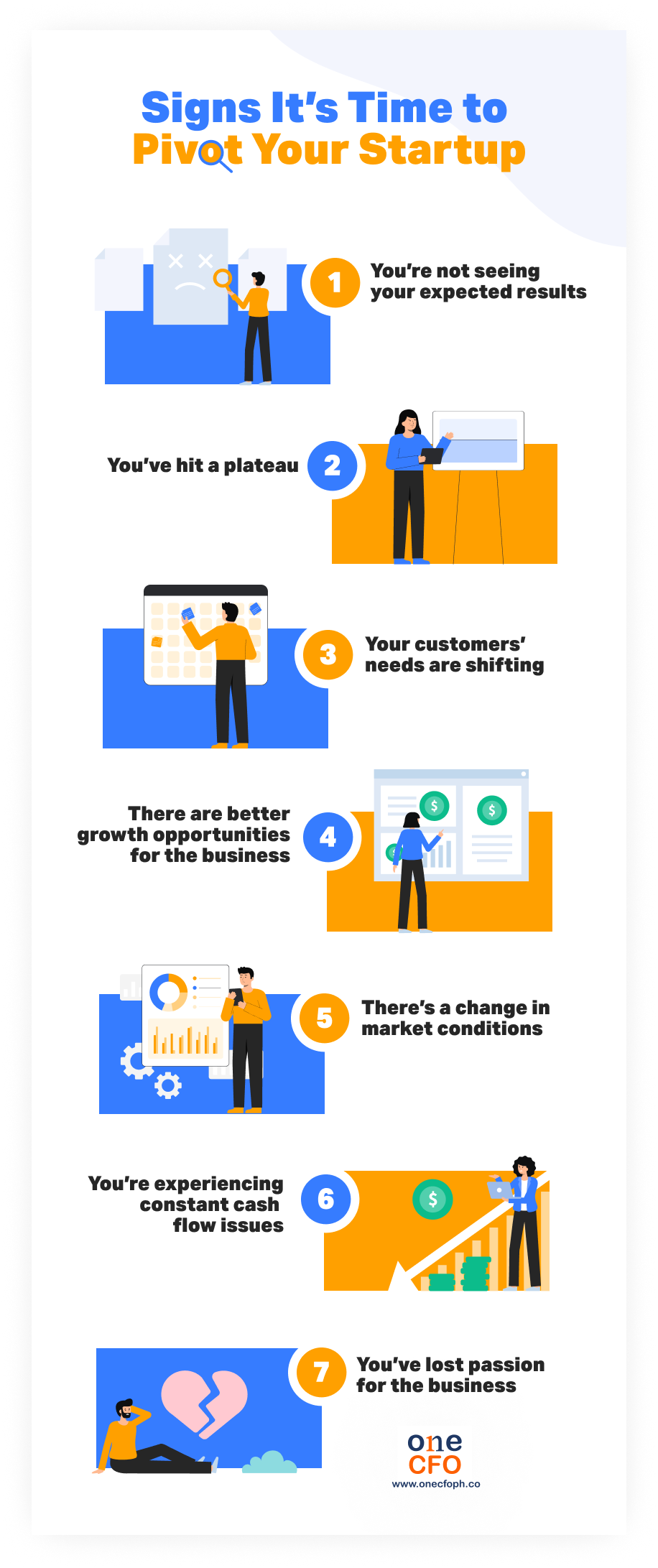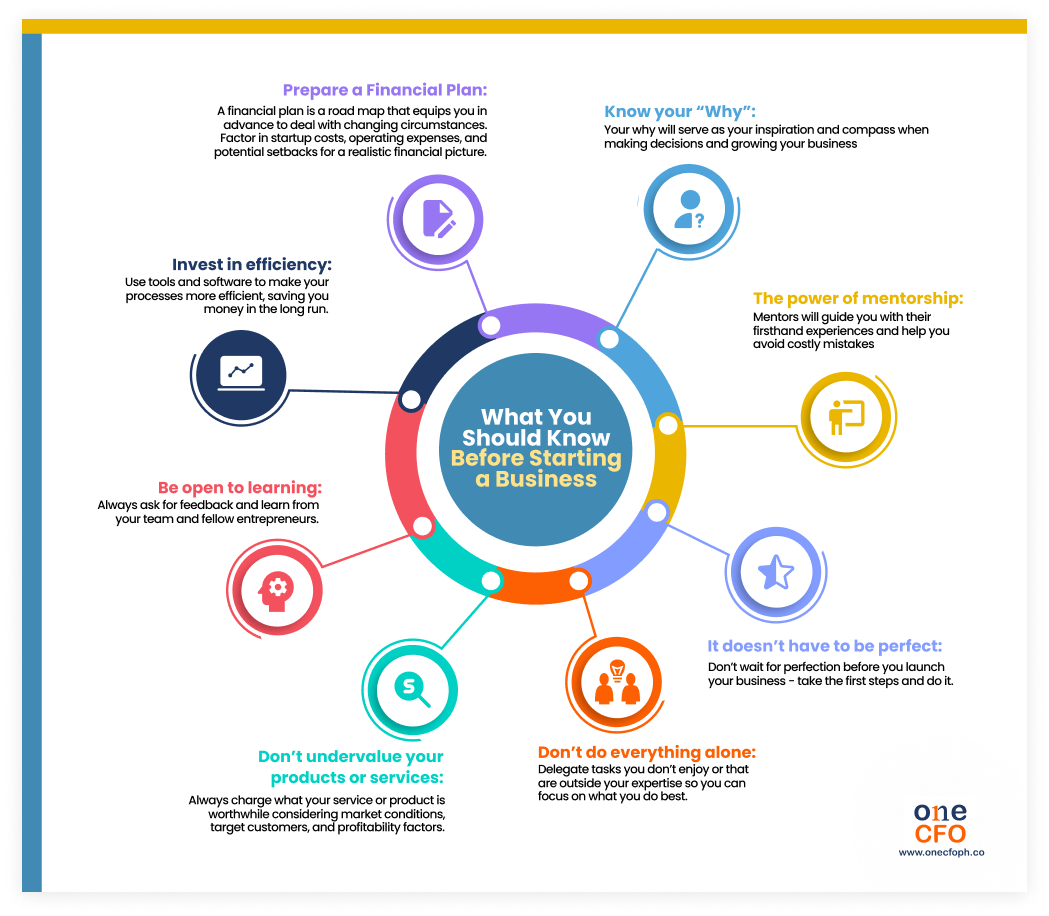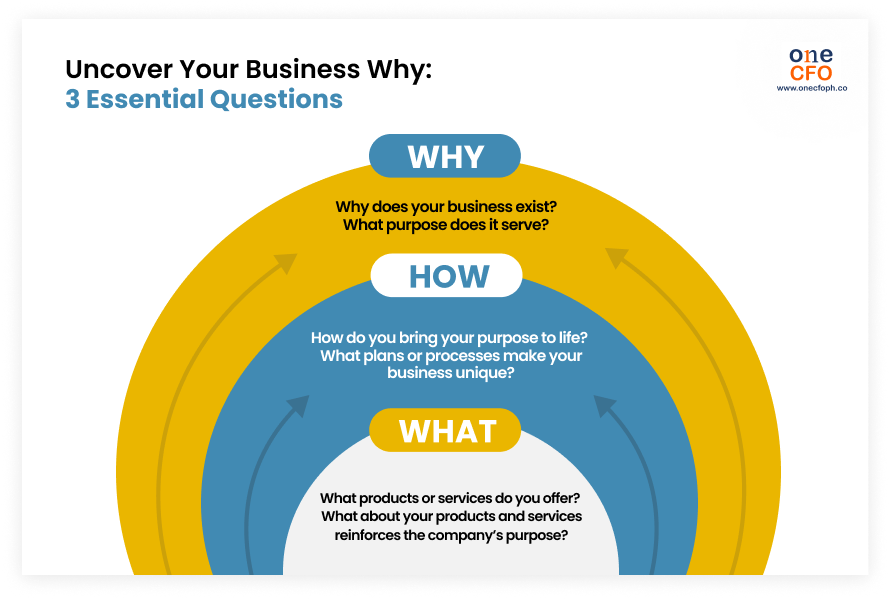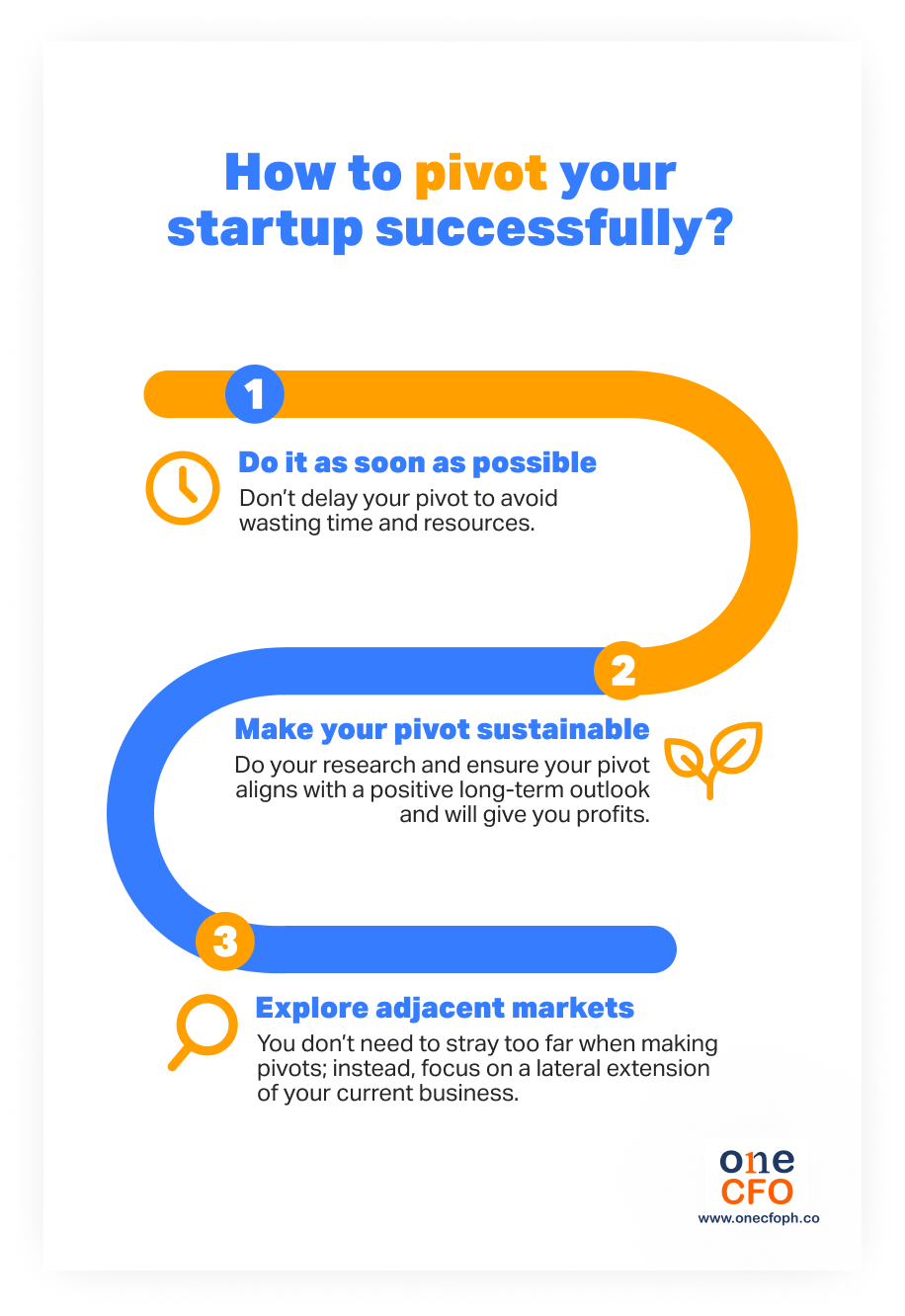
May 15, 2023 | 4:18 pm
Table of Contents
Adaptability is the secret weapon of successful startups. When faced with market shifts or
evolving goals, being flexible comes in handy when there are signs that the startup needs to
pivot.
While changes can be uncomfortable, pivoting showcases your ingenuity in recognizing flaws
in your startup and your adaptability to make the necessary changes to overcome these
hurdles.
Pivoting your startup doesn’t necessarily mean overhauling an entire business idea. Small
changes, such as product or marketing strategy adjustments, are considered pivots.
But how do you know when to pivot your startup?
Some signs to watch for as a business owner include declining metrics, slow growth, and
unsatisfied customers. Once you consistently see these signs, it may be time to rethink your
strategy and plan a pivot.
Read on to learn more about the different signs every startup founder should look out for
before pivoting and how you can successfully do it.
Why is pivoting important in startups?
A startup or business pivot is a shift or change in business strategy, mainly because the
business’s target market isn’t buying its products or services. Other common reasons for a
pivot could be changes in industry trends or the current business model not working.
Startup founders don’t always hit the bullseye with their first strategy or business model.
Rather, a startup’s success often hinges on discovering the right product-market fit, which
involves multiple tests and pivots to determine how to fully meet customers’ needs.
Pivoting is essential because it allows founders to be flexible and make changes to their
business to achieve a higher level of product-market fit.
Notably, many famous companies today, like Instagram, Netflix, and Twitter (now X), are far
from what they originally were and have pivoted their way to success.
When should you pivot your startup?
It’s normal for startups to experience ups and downs; you only need to push through.
However, some telltale signs could indicate that it may be time for you to pivot to some
degree.
Here are some of the signs you should look out for before pivoting your startup:

#1 You’re not seeing your expected results
One of the most evident signs that you need to change something in the business is when
you’re not seeing the expected results.
Defining the key metrics that indicate whether
you’re achieving your goals is essential when
creating business plans. These metrics will depend on your growth stage and may include:
Tracking metrics can help founders see if they’re achieving good results. Of course, it’s also necessary to be realistic with your timeline, as some results need more time to be realized. But it might be time for a change if you're consistently missing the mark.
#2 You’ve hit a plateau
You know you’ve reached a plateau when your startup’s growth is very slow or absent.
Surprisingly, this event can also happen even if you observed steady growth previously.
Take working out at a gym as an example. When you consistently do your workouts, you’ll
initially see gains and improvements in your body. But after doing the same thing for a
while, you’ll observe yourself not improving much or hitting a fitness plateau. This same
scenario can happen in a business.
Once you feel your growth slowing to a crawl, or worse, coming to a halt, you should start
investigating and developing fresh ideas to turn your startup around. You can improve your
business efficiency
or revamp your previous working strategies.
#3 Your customers’ needs are changing
Like anything else, your customers’ behavior and needs are constantly changing. As a
founder, it’s your job to determine the shifts in your customers’ demands and keep up.
Some indicative signs that your offerings no longer serve your audience are declining
satisfaction ratings, failure to attract new customers, and customers switching to
competitor brands.
When you start seeing weak demand from your target market, it’s time to create a strategy to
get your customers back and attract new ones.
An example of a startup pivot to address changes in customer needs was how Grab shifted its
focus from ride-hailing services to on-demand delivery during the pandemic. Since demand for
ride services dropped, the company worked closely with the government to allow their car
drivers to deliver food, too.
Staying proactive is vital in monitoring your clients’ changing needs. One of the lessons to
know as a founder is to be open to learning from your customers. Always ask your customers
for feedback on how they can enjoy your products better, and take their suggestions to
heart.
Here are other lessons to learn not just when starting a business but also when managing
one:

#4 Better growth opportunities
Another indication you should pivot is when your startup has a more significant opportunity
to grow. Finding these opportunities doesn’t mean you need to rebuild your whole company - a
simple switch in direction can do.
For example, one of your products is significantly outshining the others or has more growth
opportunities. In this scenario, it makes more sense to capitalize on what’s working and
focus on this specific product.
An example of a startup that pivoted this way is Digest, a legal research company in
the
Philippines.
Digest was originally focused on offering legal services to businesses but has pivoted to
become a software product that provides lawyers and law students with access to documented
cases and more. The startup’s decision to offer a software as a service (SaaS) product has
made it more attractive to users and positively impacted its recurring revenue.
#5 Change in market conditions or industry trends
It’s also essential to consider the long-term outlook of your business and stay updated on
industry trends. Doing so lets you quickly pivot to where your customers need you while
still having enough capital and resources.
Take Netflix, the streaming giant, as an example. This
business started as a DVD-by-mail
rental service. Still, it was able to ride the wave of digital innovation when it finally
introduced its streaming service. Now that DVDs have become obsolete, Netflix remains one of
the biggest names in the entertainment industry due to its quick action and innovation.
Here are some steps you can take when strategizing for your business:
#6 Cash flow issues
A glaring sign you need to pivot your business is if you’re constantly experiencing cash flow issues, which include poor
sales and continuously increasing costs.
Negative cash flow can sometimes be expected, especially if you just invested in something
for the business. However, suppose you see yourself always in the red, which means you spend
more than you earn. In that case, you should start changing strategies or risk failing your
business.
Of course, there are quick solutions you can implement when you find
yourself in a cash
crunch. The video below recommends measures to avoid cash flow issues.
However, if these preventative measures or solutions still don’t work, it may be time for a pivot in your startup.
#7. You’ve lost passion
As a founder, you should set an example by showing up with energy and passion for the
company. This is not to say you’re not allowed to feel tired - but if you find yourself
constantly lacking enthusiasm, just doing the bare minimum to get by, this is a sign to
freshen things up.
A lack of excitement for your startup can manifest as constantly feeling tired or lacking
focus on running the company.
When this happens, you must revisit your “why” or the reason you started your venture in the
first place. Use your “why” to reinspire yourself and look for things you can change to make
the business exciting again.
If you need help solidifying your “why” in running your startup, you can use these essential
questions to understand your purpose better:

How to pivot your startup?
Now that you know when you should pivot your startup, the next question is how should you do it. Here are some steps to make your pivot successful:

#1 Do it as soon as possible
When making a pivot, it is most important to do it as soon as possible. This way, you can
avoid wasting precious time, money, and effort trying to implement a strategy that may no
longer work.
Here are reasons why you need to act quickly:
#2 Make sure your pivot is sustainable
The change or pivot you’ll implement should be sustainable in terms of long-term outlook and
profitability. Pivoting can take a lot of resources, so you want to ensure your investments
will be worth it.
To do so, you must align your pivot with trends that are here to stay and try to address the
needs that come with them. For example, a company selling office supplies can start
marketing more to remote workers by offering products like ergonomic chairs, desks, or
monitors that can be used in a work-from-home setting.
Before pivoting, it’s best to research, consider the investments you need to make, and
budget accordingly.
If your startup lacks capital to support its pivot, there are ways for you to raise funds
from investors or alternative sources, such as grants. When fundraising, preparing business
plans you can present to investors is critical to show how you’ll use their investment to
grow your startup further.
Watch this video for more insights on fundraising strategies for your startup:
#3 Explore adjacent markets
When pivoting your startup, you may not have to go far. It's smarter to build on what you
already have rather than start over completely.
You can look for markets adjacent or related to your business and see how you can cater to
them. Assess your company’s strengths and weaknesses, and see which parts of the business
you can keep or improve on when you pivot to a new market.
For example, a startup application focused on fitness tracking could expand or pivot to an
adjacent market by adding meal planning and nutrition tracking features. For this pivot, the
startup can use its existing infrastructure and mobile app expertise to build more features
while offering extra features that complement its main business idea.
This example shows that you don’t need to completely abandon your original offerings but
instead explore related markets.
Keep your startup competitive through pivoting
Some startups may need to pivot multiple times to find something that works. So, if you find
yourself in the same spot, don’t relinquish your company!
Knowing when to pivot your startup and how to do it successfully helps strengthen a thriving
company and save a drowning one. By tracking your metrics, watching out for opportunities,
and focusing on your customers’ needs, you can quickly identify when it might be the time
for a good change.
Business pivots can be challenging, especially for startup founders. But don’t sweat it
—OneCFO is here to guide you through them!
OneCFO is your partner for growth, providing
strategic financial guidance to startups of all
stages. With our team of experts, we can help you spot early signs or opportunities to pivot
and guide you through the changes you need to make.
Visit us at onecfoph.co or reach out to us at [email protected] to
learn how we can help you
pivot and improve your business and achieve success.
Read our disclaimer here.